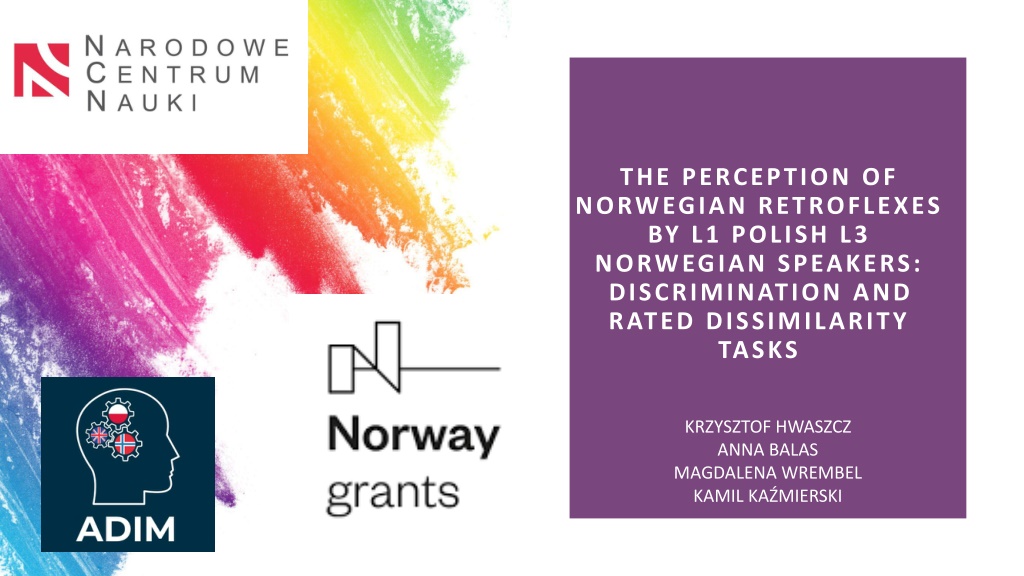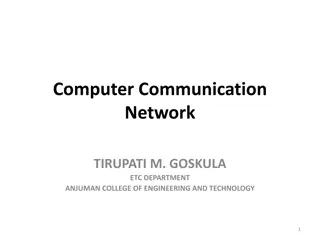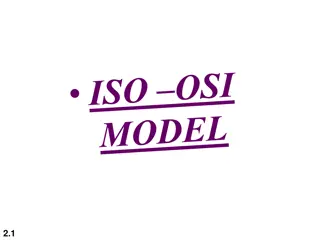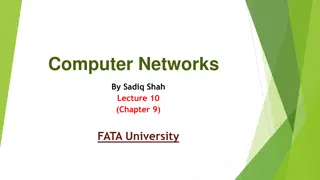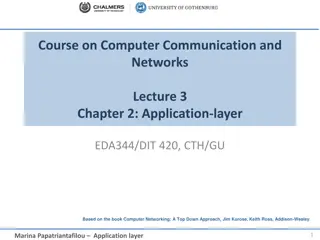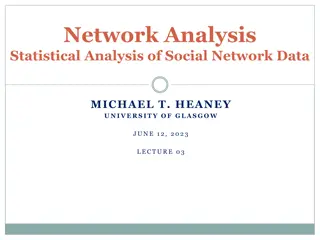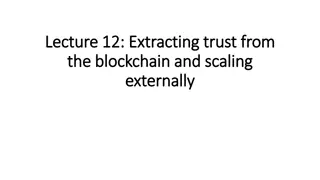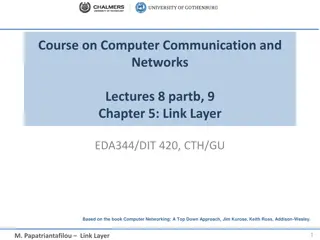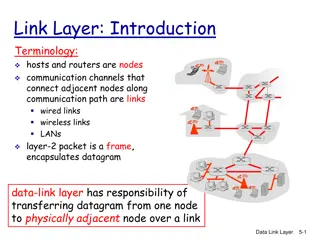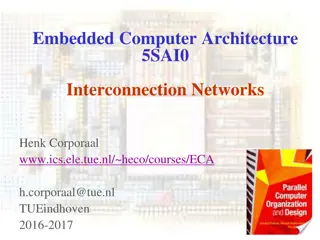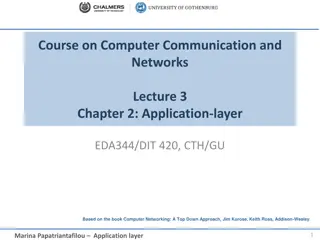Computer Networks: Network Layer Services and Performance
The network layer in the TCP/IP protocol suite is responsible for host-to-host delivery of datagrams, providing essential services such as packetizing, routing, and forwarding. Network performance metrics include delay, throughput, and packet loss, influenced by factors like transmission delay and propagation delay.
Download Presentation

Please find below an Image/Link to download the presentation.
The content on the website is provided AS IS for your information and personal use only. It may not be sold, licensed, or shared on other websites without obtaining consent from the author.If you encounter any issues during the download, it is possible that the publisher has removed the file from their server.
You are allowed to download the files provided on this website for personal or commercial use, subject to the condition that they are used lawfully. All files are the property of their respective owners.
The content on the website is provided AS IS for your information and personal use only. It may not be sold, licensed, or shared on other websites without obtaining consent from the author.
E N D
Presentation Transcript
THE PERCEPTION OF NORWEGIAN RETROFLEXES BY L1 POLISH L3 NORWEGIAN SPEAKERS: DISCRIMINATION AND RATED DISSIMILARITY TASKS KRZYSZTOF HWASZCZ ANNA BALAS MAGDALENA WREMBEL KAMIL KA MIERSKI
THEORETICAL BACKGROUND Retroflexion is traditionally described as an articulation involving the bending backwards of the tongue tip (e.g., Ladefoged and Maddieson 1996, Trask 1996). Criteria for retroflexes Hamann (2003: 32): : Apicality Posteriority Sublingual cavity Retraction N.B. bending backwards of the tongue is not universally valid. Cross-linguistically, retroflexes are considered to be marked (Greenberg 1966) Retroflexes occur relatively infrequently and only in large inventories (Maddieson 1984); they are acquired late. The degree of perceived cross-linguistic similarity between the learner sL1 and L2 is claimed to mediate discrimination of L2 sounds (Best, 1995, Flege and Bohn 2021, Cebrian 2022). Perceived cross-linguistic similarity has not been investigated from multilingual perspective.
RETROFLEXES IN NORWEGIAN, ENGLISH AND POLISH: NO FULL AGREEMENT Norwegian a series of coronal consonants distinguished by retroflexion: alveolar /t, d, s, l, n/ and retroflex / , , , , / (cf. Kristoffersen 2000: 23 controversy about / / /) Polish sibilants have a controversial retroflex status (Hamann (2002, 2004), Lorenc (2018), Hall (1997a, 1997b) ygis and Hamann (2003), ygis (2005), ygis et al. (2012), Padgett and ygis (2007), ygis and Padgett (2010)). cues to retroflexion are argued to be manifested in / /, / /, / t / and /d /; cues to allophonic retroflexion in [ ] and [ ] ( ygis 2005; ygis, Pape & Jesus 2012); American English only has / /;
RETROFLEXES IN NORWEGIAN, ENGLISH AND POLISH Hypotheses: Polish / / vs. Norwegian / / potentially closer counterparts; Norwegian / , / vs. Polish allophonic [ , ]; Remaining Norwegian retroflex sounds / , / retroflex counterparts in Polish; We hypothesize gradiance in perceptual salience. Norwegian Polish English nasal / / no close plosive (voiceless) / / [ ] plosive (voiced) / / [ ] fricative (voiceless) / - / / / fricative (voiced) / / affricate (voiceless) /t / affricate (voiced) /d / approximant / / / /
STUDY OBJECTIVES We aim to investigate the perception of Polish and Norwegian retroflexes by L1 Polish L2 English L3 Norwegian learners; specifically: Assessment of cross-linguistics (dis)similarity of retroflexes and similar non-retroflex sounds; How the perceived similarity is mediated by the presence or absence of retroflexion. Discrimination of Norwegian retroflexes/non-retroflexes;
RESEARCH QUESTIONS What is the degree of perceived similarity between Norwegian retroflexes and similar retroflex/non-retroflex sounds in Polish and English? 1. What are the discrimination rates for different pairs of Norwegian retroflexes: / -s/, / -t/, / -d/, / -n/ and / -l/? Are there significant differences in the discrimination of the five experimental retroflex non-retroflex pairs, and if so, do relative difficulties differ with experience? 2.
STUDY DESIGN PsychoPy Tasks: Rated (dis-)similarity task (RDT) Oddity categorial discrimination Participants: subtracted language group design (Westergaard, Mitrofanova, Rodina, Slabakova 2023) Experimental trilingual group: L1 Polish, L2 English, L3 Norwegian: 33 Control bilingual group: L1 Polish, L2 English: 35 Control native group: L1 Norwegian, L2 English: 13
RATED (DIS-)SIMILARITY TASK: PROCEDURE Participants: experimental trilingual group & control bilingual group . Task: grade the perceived similarity between Norwegian and Polish or between Norwegian and English sounds on a 7-point scale. 1 - 2 - 3 - 4 - 5 - 6 - 7 dissimilar very very similar Focus on the consonant in the middle. example NO token 1A example PL token 1B example NO token 2A example EN token 2B example NO token 3A example PL token 3B example NO token 3A example EN token 4B
RATED (DIS-)SIMILARITY TASK: STIMULI The subjects hear a pair of nonce words: one with a Norwegian consonant, another with either a Polish or an English consonant. W1 W2 Norwegian Polish English / /: /'g / /t/: /'gata/ /t /: /'gat a/ /t/: /'g t / /t /: /'g t / /t/: /'gata/ /t/: /'gata/ /t /: /'gat a/ /t/: /'g t / /t /: /'g t / / /: /'g / /d/: /'gada/ /d /: /'gad a/ /d/: /'g d / /d /: /'g d / /d/: /'g d / /d/: /'gada/ /d /: /'gad a/ /d/: /'g d / /d /: /'g d / / - /: /'g / /s/: /'gasa/ / /: /'ga a/ /s/: /'g s / / / /'g / /s/: /'g s / /s/: /'gasa/ / /: /'ga a/ /s/: /'g s / / / /'g / / /: /'ga a/ /l/: /'gala/ /r/: /'gara/ /l/: /'g l / /r/: /'g r / /l/: /'gala/ /l/: /'gala/ /r/: /'gara/ /l/: /'g l / /r/: /'g r / / /: /'ga a/ /n/: /'gana/ / /: /'ga a/ /n/: /'g n / / /: /'g / /n/: /'gana/ /n/: /'gana/ / /: /'ga a/ /n/: /'g n / / /: /'g /
RATED (DIS-)SIMILARITY TASK: STIMULI GROUPING Conditions: light green: matching with regard to retroflexion and the same place and manner of articulation (match, same_P&MoA) dark green: matching with regard to retroflexion and with different place and/or manner of articulation (match, diff P&MoA) white: non-matching with regard to retroflexion and the same place and manner of articulation (non-match, same P&MoA) grey: non-matching with regard to retroflexion with different place and/or manner of articulation (non-match, diff P&MoA) W1 W2 Norwegian / /:/'g / /t/:/'gata/ / /:/'g / /d/:/'g d / / /:/'g / /s/:/'g s / / /:/'ga a/ /l/:/'gala/ / /:/'ga a/ /n/:/'gana/ Polish English /t/: /'gata/ /t/: /'gata/ /d/: /'gada/ /d/: /'gada/ /s/: /'gasa/ /s/: /'gasa/ /l/: /'gala/ /l/: /'gala/ /n/: /'gana/ /n/: /'gana/ /t /:/'gat a/ /t /:/'gat a/ /d /: /'gad a/ /d /: /'gad a/ / /:/'ga a/ / /:/'ga a/ /r/: /'gara/ /r/: /'gara/ / /:/'ga a/ / /:/'ga a/ /t/: /'g t / /t/: /'g t / /d/: /'g d / /d/: /'g d / /s/: /'g s / /s/: /'g s / /l/: /'g l / /l/: /'g l / /n/: /'g n / /n/: /'g n / /t /: /'g t / /t /: /'g t / /d /:/'g d / /d /:/'g d / / / /'g / / / /'g / /r/: /'g r / /r/: /'g r / / /:/'g / / /:/'g /
RATED (DIS-)SIMILARITY TASK: HYPOTHESIS We hypothesized a hierarchy which demonstrates the gradation of phonological proximity based on retroflexion and place and/or manner of articulation (P&MoA): gradually from the most similar (1) no. condition retroflexion place and/or manner of articulation + + 1 2 3 4 + to the least similar (4) match, same P&MoA What will take precedence? - matching retroflexion - matching place and/or manner of articulation? non-match, same P&MoA + match, diff P&MoA non-match, diff P&MoA
RATED (DIS-)SIMILARITY TASK: RESULTS ACCORDING TO MATCHING RETROFLEXION AND P&M OF ARTICULATION The comparison of 33 instructed L3 learners' rating and their reaction time for different conditions regarding retroflexion and place and/ord manner of articulation 7 Matching place and/or manner of articulation > matching retroflexion. 6.13 6 5 4.54 the degree of similarity 4 NO vs. PL + NO vs. EN 3.11 3 2.68 2 1.677 1.614 1,601 1.415 1 match, same P&MoA non-match, same P&MoA 2 match, diff P&MoA non-match, diff P&MoA light green 1 white dark green grey 4 3 rating [scale 1-7] reaction time [s] The proposed hierarchy of phonological proximity
RATED (DIS-)SIMILARITY: HYPOTHESIS ON THE ROLE OF LANGUAGE Do (dis-)similarity ratings in each condition differ according to the language (L1/L2)? We hypothesize that the dissimilarity ratings for both L1 Polish and L2 English will be arranged according to the proposed hierarchy of phonological proximity. gradually from the most similar (1) condition retroflexion place and/or manner of articulation + + 1 2 3 4 + to the least similar (4) match, same P&MoA - of articulation take precedence over matching retroflexion for both L1 Polish and L2 English? - Are there differences between L1 and L2? Will matching place and/or manner non-match, same P&MoA + match, diff P&MoA non-match, diff P&MoA
RATED (DIS-)SIMILARITY TASK RESULTS: SPLIT BY LANGUAGE The comparison of 33 instructed L3 learners' rating and their reaction time for different conditions regarding retroflexion and place and/ord manner of articulation 7 trend line across conditions for L1 Polish 6.23 5.93 6 4.75 5 4.27 trend line across conditions for L2 English 4 PL 3.38 EN 3.16 2.9 EN 3 PL 2.28 PL EN EN 2 PL Reaction times [s]: 1 match, diff P&MoA match, same P&MoA non-match, same P&MoA 2 non-match, diff P&MoA light green white dark green grey 4 condition PL EN 3 1 PL rating [scale 1-7] EN rating [scale 1-7] 1.397 1.524 match, same P&MoA non-match, same P&MoA 1.758 1.612 For L2 English, matching retroflexion yielded lower similarity ratings than non-matching retroflexion in the case of different P&MoA. Comparing matching retroflexion (match, same P&MoA and match, diff P&MoA) with non- matching retroflexion (non-match, same P&MoA and non-match, diff P&MoA), we found that matching retroflexion elicited higher perceived similarity values for L1 than for L2, whereas non-matching retroflexion elicited higher perceived similarity values for L2 than for L1 . 1.686 1.533 match, diff P&MoA non-match,_diff P&MoA 1.476 1.780
RATED (DIS-)SIMILARITY TASK RESULTS Are there differences across groups in similarity ratings as a function of condition and language? A mixed-effects ordinal logistic regression of similarity ratings as a function of three treatment-coded categorical predictors: condition (matching/non-matching retroflexion and P and/or manner of articulation), language of the non-Norwegian phone, group and their three-way interaction. By-participant random intercept. Significant effect of group: Pr(>Chisq) < 0.01 *** Significant effect of language: Pr(>Chisq) < 0.01 *** Significant effect of condition: Pr(>Chisq) < 0.01 *** Significance of language:condition:group interaction: Pr(>Chisq) < 0.01 *** vs.
RATED (DIS-)SIMILARITY TASK RESULTS: LINEAR REGRESSION OF REACTION TIMES A mixed-effects linear regression model of log-transformed reaction times a function of three treatment-coded categorical predictors: condition, language of the non-Norwegian phone, group vs. and their three-way interaction. By-participant random intercept. Significance of group: Pr(>Chisq) < 0.01 *** Significance of condition: Pr(>Chisq) < 0.01 *** Significance of language: Pr(>Chisq) < 0.01 ***
DISCRIMINATION TASK IN L3 NORWEGIAN Categorial Discrimination task (e.g., A1 A2 B1): Which of the words is different? A1 *garla /g / A2 *garla /g / B1 *gala /g l / Oddity paradigm All twelve possible combinations were presented randomly over trials within a test A1A2B1, A1B1A2, B1A1A2, A1B1B2, B1A1B2, B1B2A1 A2A1B1, A2B1A1, B1A2A1, A1B2B1, B2A1B1, B2B1A1 where: A1 and A2 a retroflex embedded in a token read by two different speakers B1 and B2 a non-retroflex embedded in a token read by two different speakers each trial consisted of three tokens read by three different speakers
DISCRIMINATION TASK: STIMULI Stimuli: retroflexes embedded in non-existing words in [C]/a/[Cr]/a/ pattern and their non-retroflex counterparts [C]/a/[Cn-r]/a/, investigated retroflexes: / , , , , /, e.g., *varta /v / vs. *vata /v t / *farda/f / vs. *fada /f d / *karla/k / vs. *kala /k l / *garna/g / vs. *gana /k n / *farsa/f / vs. *fasa /f s / /a/ the vowel /a/ [C] one of the consonants /g/ /v/ /k/ or /f/ [Cr] one of the consonants which is a retroflex: / , , , , / [Cn-r] one of the consonants which is a non-retroflex: /t, d, l, n, s/
DISCRIMINATION TASK: HYPOTHESIS We hypothesize that discrimination in pairs involving the retroflex / - / as opposed to the non-retroflex /s/ may be enhanced compared to other retroflex-non-retroflex pairs, as learners are familiar with this phonemic distinction from their L1 or L2. Disrimination accuracy for stop retroflexes is hypothesized to be intermediate, because of similarity to allophonic realizations. Lowest accuracy rates are hypothesized for sonorant / , /retroflexes than for other retroflex-non-retroflex pairs, as learners are not familiar with the former either from their L1 or L2. Additionally, / ,-l/ has been undergoing neutralization in Norwegian.
DISCRIMINATION TASK: ACCURACY SCORES ACROSS GROUPS Binomial regression model. Significance of groups: Pr(>Chisq) < 0.01R P value adjustment: tukey method for comparing a family of 3 estimates was used. Accuracy hierarchy: trilinguals > natives > bilinguals Term native vs. biliguals native vs. trilinguals bilinguals vs. trilingual Estimate 0.450 p-value 0.0518 -0.334 0.2013 -0.785 <.0001
DISCRIMINATION TASK: RESULTS Ceiling discrimination of / /-/s/ in the case of trilinguals Trilinguals / /-/n/. Bilinguals performed worse for the Norwegian pairs where there isn t a a similar retroflex phoneme in L1 Polish. Below chance level discrimination rates for / /-/l/; the much lower accuracy for / /-/l/ compared to all other conditions is what trillinguals have in common with native listeners , not with bilinguals, also because the accuracy for / /-/t/ and / /-/d/ and / /-/n/ for trilinguals is higher than for bilinguals. and bilinguals and native listeners have highly accurate scores for / /-/t/ and / /-/d/ pairs; slightly lower results for The results can generally be accounted for by the familiarity with L1 retroflexion patterns. Phonemic vs. allophonic status of retroflex sounds in Polish surfaces in Norwegian retroflex perception.
DISCRIMINATION TASK: RESULTS ACROSS GROUPS IN ACCURACY SCORES AS A FUNCTION OF CONDITION Are there differences between groups in accuracy scores as a function of condition? Hypotheses are confirmed, accuracy / /-/s/> retroflex stop > sonorants, but there is an unexpected difference between / /-/n/ and / -l/ perception. Only significant contrasts were selected: condition = / /-/s/: - p <.0001*** - p <.0001*** condition = / /-/t/: - p <.0001*** - p <.0001*** condition = / /-/d/: - p <.0001*** - p <.0001*** condition = / /-/n/: - p <.0001*** - p <.0001***
LOW ACCURACY OF // DISCRIMINATION Frequency (corups and dictionary frequency): around 1% of items, at least four times less frequent than other retroflexes in Norwegian. Articulatory similarity of dark [ ] and retroflex / /? Ongoing change from a denti-alveolar laminal type into an alveolar apical, which has led to neutralization of the unmarked lateral and the one from the retroflex series. The product of the neutralization is slightly retroflex (Vanvik 1972, Jahr 1981). Endresen (1991): varying between alveolar and postalveolar. Kristoffersen (2000): it corresponds to the retroflex series of stops and sibilants.
DISCRIMINATION TASK: REACTION TIME RESULTS ACROSS GROUPS Pr(>Chisq) < 0.01*** A likelihood ratio test shows that the model with group (and its interaction with condition) is significantly different from a model without group. Groups are different in terms of reaction times.
DISCRIMINATION TASK: REACTION TIME RESULTS ACROSS GROUPS AS A FUNCTION OF CONDITION Generally, the lower the accuracy of discrimination, the higher the RTs. Are there differences between groups in reaction times as a function of condition? Only significant contrasts were selected: condition = / /-/t/: native bilingual p <.0001 native trilingual p=0.0432 bilingual trilingual p=0.0252 condition = / /-/d/: native bilingual p = 0.0005 bilingual trilingual p = 0.0068 condition = / -l/ : native trilingual p = 0.0072
DISCUSSION: DISCRIMINATION Hypotheses are confirmed, accuracy / /-/s/> retroflex stop > sonorants, but there is a difference between / /-/n/ and // -l/ perception, due to neutralization of / -l/. Trilingual and target language advantage in wholesale comparison: trilinguals were more accurate than native speakers and native speakers were more accurate than bilinguals. There are significant differences in accuracy of perception of Norwegian pairs of retroflexes: / -s/, / -t/, / -d/, / -n/ and / -l/ and relative difficulties diminish with experience with Norwegian. Higher reaction times for bilinguals. Higher reaction times for contrasts with lower discrimination accuracy/ for more challenging contrasts.
DISCUSSION: RATED (DIS-)SIMILARITY TASK The attested hierarchy of phonological proximity: matching retroflexion, same P&M > non-matching retroflexion, same P&M > matching retroflexion, different P&M > non-matching retroflexion, different P&M All: language, group and condition turned out to be significant factors in the case of both rated (dis)similarity scores and reaction times. Matching retroflexion elicited higher goodness ratings in the case of trilinguals, familiar with retroflexion from both L1 and L3 than for bilinguals from whom only/mainly the L1 can be the source of CLI.
DISCUSSION: RDT VS. DISCRIMINATION The sounds that were judged to be more similar in RDT had lower accuracy scores in the discrimination task -> perceived cross-linguistic similarity mediates discrimination, not only in L2 perception (Cebrian 2022, Flege and Bohn 2021, Best 1995), but also in cross-linguistic perception by multilinguals, with all its complexities. Both tasks: Additional evidence that there are retroflexes in Polish. Gradiance in perceptual salience. The importance of experience with a given contrast.
FURTHER RESEARCH Frequency vs. accuracy in discrimination: the study revealed that / /-/s/ which are phonemes in Polish are much more accurately discriminated than / /-/t/ or / /-/d/, the retroflex stop variants having an allophonic, but not a phonemic status in L1 Polish. Future disentangle the role of phonemic/allophonic status vs. the effects of frequency of occurrence. Cf. the above with the 1st hypothesis of the SLM (Flege 1995, Flege and Bohn 2021): Sounds in the L1 and L2 are related perceptually to one another at a position sensitive allophonic level, rather than at a more abstract phonemic level.
SELECTED REFERENCES Cebrian, J. (2022). Perception of English and Catalan vowels by English and Catalan listeners: Part II. Perceptual vs ecphoric similarity. Journal of the Acoustical Society of America, 152(5), 2781-2793. Flege, J.E. & Bohn, O-S. (2021). The revised speech learning model (SLM-r). In: R. Wayland (ed.) Second language speech learning: Theoretical and empirical progress. Cambridge: Cambridge University Press, pp. 3-83. Greenberg, J. (1966). Universals of language. Cambridge, MA: MIT Press. Maddieson, I. (1984) Patterns of sounds. Cambridge: Cambridge University Press. Westergaard, M., Mitrofanova, N., Rodina, Y. & Slabakova, R. 2023. Full transfer potential in L3/Ln acquisition: Cross-linguistic influence as a property-by-property process. In Cabrelli, J. Chauch- Orozco, A., Gonz lez Alonso, J. Pereira Soares, S.M., Puig-Mayenco, E. & Rothman, J. The Cambridge handbook in thrid language acquisition. Pp. 219-242. Cambridge: Cambridge University Press. ygis, M. (2005). Non(retroflexivity) of Slavic affricates and its motivation. The case of Polish and Czech. ZAS Papers in Linguistics, 42, 69-115. ygis, M., Pape D. L., & Jesus L. (2012). (Non)retroflex Slavic affricates and their motivation. Evidence from Czech and Polish. Journal of International Phonetic Association, 42, 281 329.
ACKNOWLEDGEMENTS: ACKNOWLEDGEMENTS: This research is supported by Norway funds/ NCN project grant GRIEG-1 (UMO-2019/34/H/HS2/00495) ADIM Across-domain investigations in multilingualism: Modeling L3 acquisition in diverse settings . Special thanks should also go to Jaros aw Weckwerth and Agnieszka Pludra for their idea of shading and help with the execution. We would also like to thank Hanna K dzierska for her help with data collection in Wroc aw and Sylwiusz ychli ski, Anna Ska ba and Zuzanna Cal for cooperation during data collection in Pozna and Szczecin. Last but not, least we are grateful to all the project team members for discussions of the research design and analysis.
